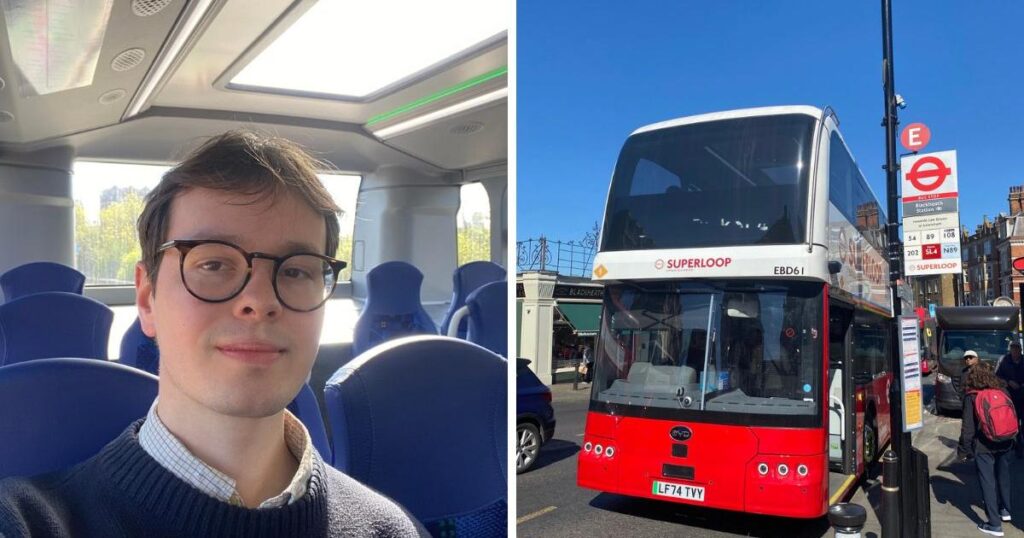On Monday (April 7), the last of the initial ten express routes was rolled out by Transport for London (TfL), coinciding with the opening of the Silvertown tunnel.
Superloop services mainly run across outer London, usually calling at fewer stops than a regular bus which means journey times should be shorter for the same £1.75 fare.
SL4 runs between Canary Wharf and Grove Park stations, travelling through the new road crossing under the Thames.

Promising a total journey time of just under 45 minutes – about how long it would take to travel between the two stations on train – TfL hopes people will quickly take to the new service.
To entice even more passengers, SL4 journeys will be free for the first 12 months of operation.
So, finding myself close to the Silvertown tunnel’s entrance in the Docklands and with no money at stake, I decided to see what all the Superloop fuss was about.
My first task was to locate the nearest bus stop. This was harder than you might think, with the area around the tunnel presenting as a concrete jumble of road bridges and underpasses.
After walking along the side of a dual carriageway, I eventually discovered a stop called Leamouth / Orchard Place closer to East India DLR station, tucked away under a flyover.

I was one of two passengers waiting for the bus here – the other told me he was a TfL employee checking that all of the Superloop branding was in place at stops along the route.
TfL promises that the route operates every eight minutes on weekdays, and I had already seen an SL4 bus whizz past me on my walk to the bus stop.
After around five minutes of waiting, another pulled into the stand. There was no denying that so far, the Superloop had passed the reliability test.
On board, the bus looked clean and new, with USB charging ports and a stop button behind every pair of seats.
Emergency green strip lighting on the bus ceiling might seem like a futuristic touch, but it was also vaguely reminiscent of the LED lights that teenage boys who post too much on TikTok seem to love.

After settling down on the top deck, which already had around a dozen seated passengers, the bus was away, providing fantastic views of the O2 on the other side of the river.
Within minutes, we were speeding through the new Silvertown tunnel.
For all its controversy, the road crossing seemed very quiet, although this was perhaps to be expected at 11am on a Monday.
At the other side of the tunnel, the bus uses the A102 dual carriageway to speed down the Greenwich Peninsula, not stopping until it reaches Shooters Hill Road.

We reached our first stop south of the river in less than ten minutes, which seemed pretty fast to me. The express bus was doing exactly what it said on the tin.
I had naively assumed that after our quick stop in Greenwich, the service would go non-stop to my destination at Blackheath station.
Instead, to my surprise, the bus proceeded to call at every stop between Shooters Hill Road and the centre of Blackheath.
The journey was further held up by roadworks in Lee Road, which brought the bus to a standstill for a good five minutes as it approached Blackheath.
The bus driver, perhaps anxious to apologise for an express service that was currently not going anywhere, diligently informed us of the delay over the tannoy.
Despite the hold up, I safely arrived at Blackheath station about 25 minutes after I first boarded the bus.

Now look – I get that roadworks, or unexpected accidents are always a possibility.
These are things that can hold up any mode of transport, and an express bus will at least find it easier to make up any lost time.
What was more confusing as a passenger was that sections of the route seemed to operate as an express bus, while other sections felt like your run-of-the-mill London bus service.
In many ways, my journey was a story of two parts. The first saw me whizz across the River Thames and down the Greenwich Peninsula, a distance of four miles, in just nine minutes.
The second saw the bus take almost twice as long to travel a quarter of that distance into Blackheath.
This must, to a certain extent, be by design, as the route has 26 stops in total, the second highest total of any Superloop route.
There is no denying that the SL4 provides a reliable and fast service between certain stops – just don’t expect to get to your destination in record time, every time you take it.




